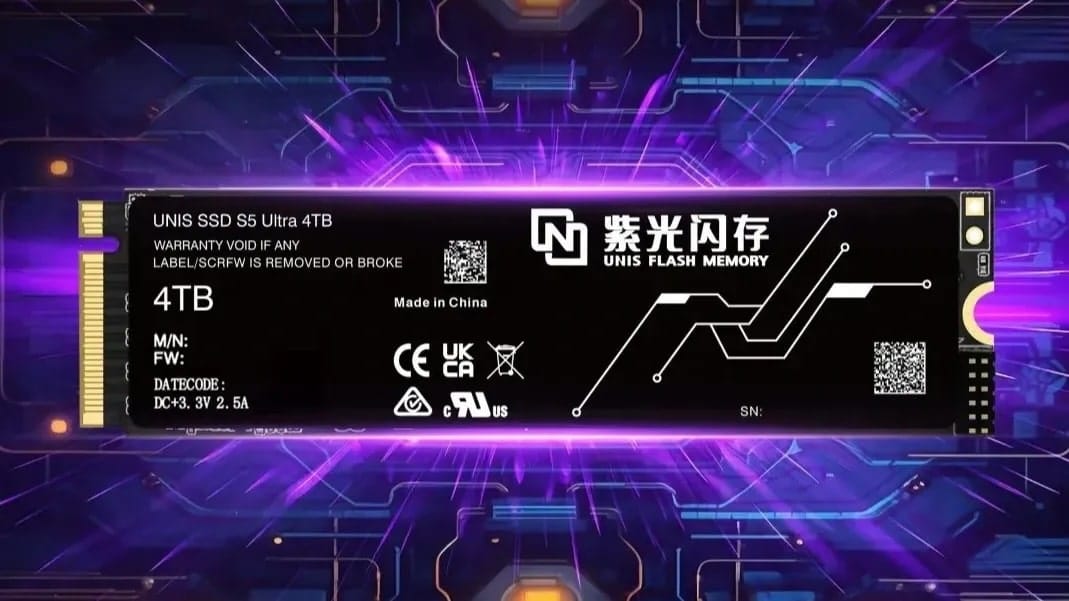UNIS Flash Memory, a Chinese manufacturer that is part of Tsinghua Unigroup, has made a significant mark in the SSD industry with the launch of its S5 series, which includes two models, the S5 and the S5 Ultra, both capable of reaching impressive speeds of up to 14,900 MB/s. This advancement positions UNIS’s new SSDs as the fastest in the world, even surpassing recognized competitors in the PCIe 5.0 SSD market.
Speed That Surpasses Limits
The new S5 and S5 Ultra SSDs from UNIS Flash Memory are positioned as market leaders, achieving sequential read speeds of 14,900 MB/s, a milestone compared to other PCIe 5.0 SSDs that barely reach 13-14 GB/s. This sequential read capability approaches the theoretical limit that the PCIe 5.0 interface can offer, placing these SSDs at the pinnacle of current storage technology.
The S5 series utilizes the PCIe 5.0 x4 interface and is built with 3D NAND TLC memory, enabling it to achieve this performance level. Despite its exceptional speeds, these drives come with a 1 mm passive graphene heatsink to help mitigate high temperatures, though a dedicated heatsink is recommended to ensure optimal performance.
Features of the S5 Model
The base model S5 from UNIS Flash Memory is an impressive SSD that achieves 14,900 MB/s in sequential read and 12,900 MB/s in sequential write. Although it lacks DRAM, it utilizes HBM (High Bandwidth Memory) and a SLC (Single-Level Cell) cache, enabling it to maintain these outstanding speeds. Additionally, the S5 model is available in 1 TB and 2 TB capacities, offering options for different storage needs.
One of the most interesting aspects of the S5 model is its ability to provide excellent value for money, as the base model outperforms other competing PCIe 5.0 SSDs in terms of read and write speeds, albeit without the advantages of a DRAM design.
The S5 Ultra: A Step Beyond
The S5 Ultra, the more advanced version of the series, incorporates a 6 nm controller and DRAM, making it the ideal choice for users seeking even greater performance and durability. In terms of speed, the S5 Ultra achieves a sequential read speed of 14,200 MB/s and a write speed of 12,700 MB/s, slightly lower than the base model but with the advantage of 1200 TBW (terabytes written) compared to the 2400 TBW of the Ultra model, ensuring greater durability and reliability for long-term storage demands.
This Ultra model is available in 2 TB and 4 TB capacities, making it ideal for those who need high-level performance in demanding work environments. With its dual PCB design and DRAM cache, the S5 Ultra is perfect for applications requiring fast and constant access to large volumes of data, such as professional workstations or servers.
Comparison with Other SSDs on the Market
When comparing UNIS’s S5 SSDs with other PCIe 5.0 models like the Samsung 9100 Pro and the Crucial T705, it is noted that the S5 outperforms all in terms of sequential read speed, with 14,900 MB/s compared to 14.8 GB/s for the Samsung 9100 Pro and 14.5 GB/s for the Crucial T705. However, the S5 Ultra is slightly slower in read speed, at 14,200 MB/s, although its sequential write speeds of 12,700 MB/s place it well above the competition.
Despite the improvements in the S5 Ultra, its write performance remains comparable to other premium models on the market. However, the main advantage of the S5 Ultra lies in its greater durability and wear resistance, making it the preferred option for users seeking long-term storage.
Performance and Use in High-Demand Applications
The S5 and S5 Ultra SSDs are perfect options for users who require high-performance storage. Thanks to their extreme speeds, these SSDs can handle large volumes of data in applications requiring high transfer capacity, such as 4K and 8K video editing, 3D rendering, high-performance PC gaming, and artificial intelligence tasks. They are also ideal for database servers and workstations that require fast and constant access to large data sets.
While the basic S5 model already offers impressive performance, the S5 Ultra, with its advanced 6 nm controller and higher durability, is the recommended option for more demanding applications that require sustained high levels of performance over long periods.
Temperatures and Cooling Recommendations
Although the S5 SSDs come with a 1 mm passive graphene heatsink, it is recommended to use an active cooling system to keep temperatures under control, especially in intensive use configurations. Dedicated heat sinks or liquid cooling systems can be an excellent option for those looking to maximize the performance of these units.
Availability and Pricing
Currently, no details have been provided about the pricing of UNIS’s S5 SSDs, although they are expected to hit the market in 1TB and 2TB for the base model, and 2TB and 4TB for the Ultra model. The first SSDs will be available on e-commerce platforms like AliExpress, and are expected to reach international markets shortly.
Conclusion
With the launch of the UNIS S5 and S5 Ultra SSDs, the Chinese manufacturer has managed to position itself at the forefront of storage technology, even surpassing some market leaders in terms of performance. With speeds of up to 14,900 MB/s, these units offer exceptional performance, ideal for users seeking the best in data transfer capabilities. Additionally, their DRAM-less design in the S5 model and with DRAM in the Ultra ensures a perfect combination of speed, durability, and reliability.
References: Tom’s Hardware and Profesional Review

